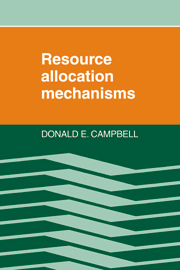Book contents
- Frontmatter
- Contents
- Preface
- Chapter 1 Introduction
- Chapter 2 Performance criteria
- Chapter 3 The Arrow–Debreu world
- Chapter 4 Uncertainty
- Chapter 5 Incentive compatibility
- Chapter 6 Existence of a competitive equilibrium
- Chapter 7 Welfare properties of the Walrasian mechanism
- Appendix 1 Elements of consumer choice
- Appendix 2 The Edgeworth exchange economy
- Appendix 3 Proof of the Shafer–Sonnenschein theorem
- References
- Author index
- Subject index
Chapter 3 - The Arrow–Debreu world
Published online by Cambridge University Press: 05 June 2012
- Frontmatter
- Contents
- Preface
- Chapter 1 Introduction
- Chapter 2 Performance criteria
- Chapter 3 The Arrow–Debreu world
- Chapter 4 Uncertainty
- Chapter 5 Incentive compatibility
- Chapter 6 Existence of a competitive equilibrium
- Chapter 7 Welfare properties of the Walrasian mechanism
- Appendix 1 Elements of consumer choice
- Appendix 2 The Edgeworth exchange economy
- Appendix 3 Proof of the Shafer–Sonnenschein theorem
- References
- Author index
- Subject index
Summary
A utility function that is sensitive only to the private goods consumption of the agent in question will be termed self-regarding. A firm's technology set is self-regarding if it does not depend on the activities of other agents. We will show that a Walrasian competitive equilibrium allocation is Pareto optimal as long as household utilities and firm technologies are self-regarding and each commodity that affects someone's utility is traded in some market. Section 3.9 demonstrates that self-regarding preferences and technologies are not really required for Pareto optimality, but the assumption of competitive behavior loses its plausibility without it.
Ead will denote the largest family of environments for which all utility functions and technology sets are self-regarding. Section 3.4 proves that a Walrasian competitive equilibrium allocation is Pareto optimal if the environment belongs to Ead. There are many members of Ead for which an equilibrium does not exist, however; this issue is taken up in Chapter 6, which shows that there is a very wide class E* of environments overlapping Ead for which equilibria exist. Therefore, the result of Section 3.4 is not vacuous. Section 3.6 will show that for every economy e in E* ∩ Ead and any Pareto-optimal allocation f of e there is an economy e′ in E* ∩ Ead that is the same as e except with respect to endowments and profit shares and such that f is a Walrasian competitive equilibrium allocation for e′ An other words, e′ is obtained from e by redistributing wealth.
- Type
- Chapter
- Information
- Resource Allocation Mechanisms , pp. 39 - 64Publisher: Cambridge University PressPrint publication year: 1987



